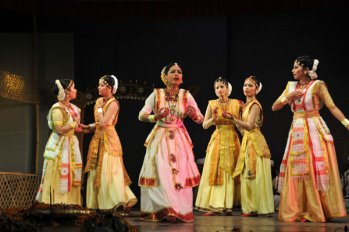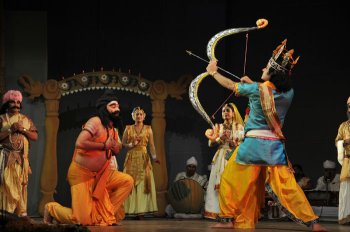
|   |

|   |
Sri Ram Vijoy Ankiya Bhaona - Dr. Sunil Kothari e-mail: sunilkothari1933@gmail.com April 27, 2013 Sankaradeva, the saint of Assam, wrote six plays which are known as Ankiya Nat Bhaona. Of the six plays, the most well known is Sri Ram Vijoy. It differs from the well known Ramayana of Valmiki and Tulasidas. The Ankiya Bhaona, which I saw presented after the book launch on 10th April 2013 at Ravindra Bhavan at Guwahati, was produced by Sattriya Kendra and was directed by Dulal Roy, renowned theatre director of Assam. Maintaining its spirit and major episodes as per the traditional dance drama, Dulal Roy has made it more amenable to the contemporary audiences. There is a saying in Sanskrit that, “Yavat sthasyanti Girayaha, saritascha mahi tale, Ramasya katha lokeshu pracharishyanti.” So far as there shall exist mountains on earth and rivers shall flow, the story of Lord Rama shall continue to spread throughout the world. The popularity of Ram Katha in all parts of India is an amazing phenomenon. Not only that, in other countries in Far East like Java, Bali, Thailand, Laos, Vietnam, Cambodia and other countries, Ramayana in its manifold versions exists and is popular as a living tradition. No wonder Sankaradeva during his pilgrimage throughout India must have seen its enactment and come across the Sanskrit text of Valmiki. However, as he wished to reach out to the people he wrote in Brajbuli (composite languages of Assamese, Hindi, Braj, Mythili), Sri Ram Vijoy Ankiya Nat which became very popular among the monks in various sattras. Sri Ram Vijoy deviates from the Ramayana of Valmiki. In its one act avatar we see that rishi Vishwamitra visits King Dasharatha’s court and requests him to send his two young sons Rama and Lakshmana with him to the forest where rishis are conducting sacrifice and the demons obstruct it. In Ankiya Nat the main role is played by Sutradhara who sings, dances and narrates the story. He announces the entrances of various characters. Prior to that, the monks perform Gayan Bayan, playing upon mridang / khol. In their spotless white flowing robes and pugrees, they create a breathtaking spectacle. 

After the preliminary purva ranga like presentation, the Sutradhara tells the story, announcing entrances of characters. Vishwamitra leaves with Rama and Lakshmana to the forest and trains them on how to aim at the enemies, how to wield the bow and arrows. When demons start disturbing the yagna, both shoot at the asuras and they are driven away. Sutradhara then announces entrance of King Janaka. He enters from under the arch. Sita and her sakhis also enter. Sita is worried about who would break the bow. Her sakhis console her and ask her not to worry. Sutradhara announces entrances of other kings. Then arrive Rama, Lakshmana and Vishwamitra, who Janaka receives respectfully. The swayamvara sequence is full of hasya rasa. Each king desirous of marrying Sita boasts about how he would lift the bow. Each one fails. One king boasts that he could lift the bow with the little finger of his left hand and to the merriment of other kings, falls flat on the floor. Departing from Valmiki and other versions of Ramayana, Sankaradeva has not shown Ravana coming to swayamvara. He is absent in the one act version of Sri Ram Vijoy Ankiya Bhaona. Sutradhara then narrates the story further and sings that finally Rama is asked by Vishwamitra to lift the bow. He succeeds in doing so and the bow breaks into two parts. Sita is relieved of her anxiety and garlands Rama. The other kings get angry and want to fight with Rama but are driven away. On way back to Ayodhya, sage Parasuram on learning of Rama's breaking the bow of Lord Shiva engages with him in a battle, is defeated and falls at the feet of Lord Rama. In the next sequence Kaushalya’s patra pravesha (entrance) is announced by Sutradhara. She receives the newlyweds in Ayodhya with joy, offers flowers and follows other rituals. The attendant maids perform Hulu dhwani, warding off evil. Sutradhara sings that having received them with proper rituals, Kaushalya asks Rama and Sita to proceed to their bed chamber. After that Bhatima is sung by all dancers/actors on the stage. In his final shloka, Sutradhara mentions the name of the author of Sri Ram Vijoy, who wrote it during the reign of King Shukladhwaja. Whoever listens to the prayers, the samajikas, the members of the audience, shall receive moksha. And with that the Ankiya Bhaona ends. All actors taking part in Ankiya Bhaona know how to dance. Dance is interspersed throughout the enactment. The female dancers perform pure dance using the various nritta passages. The use of bow, mace, sword etc and the colourful costumes and crowns are attractive. The overall visual appeal is very impressive. The singing by the musicians at the back carries forward the narrative. Dulal Roy has lent a touch of sophistication to the presentation and delivery of dialogues. Also the entrances were well synchronized. The form of dance-drama replete with vachikabhinaya and interludes by Sutradhara was well maintained. Bulganin, the young actor playing role of Sutradhara is very gifted, with powerful voice and sings well. His dancing abilities were well coordinated. I am told that he is an actor and has not studied Sattriya dance. But with more practice he shall do well. Jibanjit Dutta and his son, well versed in Sattriya dance, performed well. Naren Baruah as Rama and Meernanda Borthakur as Kaushalya performed with elan and stood out for their acting and dancing abilities. The teamwork of more than forty artistes, musicians, backstage workers, set designers was exemplary. Under the guidance of Dulal Roy, the present version of Sri Ram Vijoy would appeal to the present generation. The purists would raise eyebrows for this treatment of the traditional form, but I feel with experience and concern, Dulal Roy has done a commendable job. The simplicity of stage and arrangement of Guru Asana were noteworthy. All traditional forms when they travel from their native locations to the metropolitan stage need certain transformations. What one has to bear in mind is to keep the spirit of the play intact and the simplicity which surrounds these traditional theatrical forms. Such presentations need to be brought to major cities to create an awareness of the wealth of Assamese theatre and dance.  Dr. Sunil Kothari is a dance historian, scholar, author and a renowned dance critic. He is Vice President of World Dance Alliance Asia Pacific India chapter, based in New Delhi. He is honored by the President of India with Padma Shri, Sangeet Natak Akademi award and Senior Critic Award from Dance Critics Association, NYC. He is a regular contributor to narthaki.com, the roving critic for monthly magazine Sruti and is a contributing editor of Nartanam for the past 12 years. |